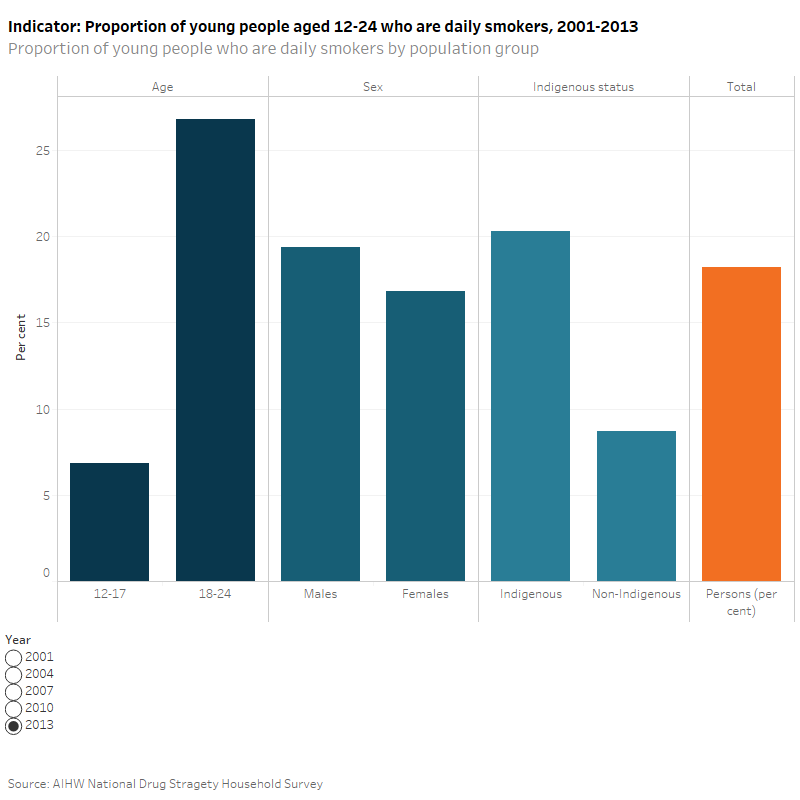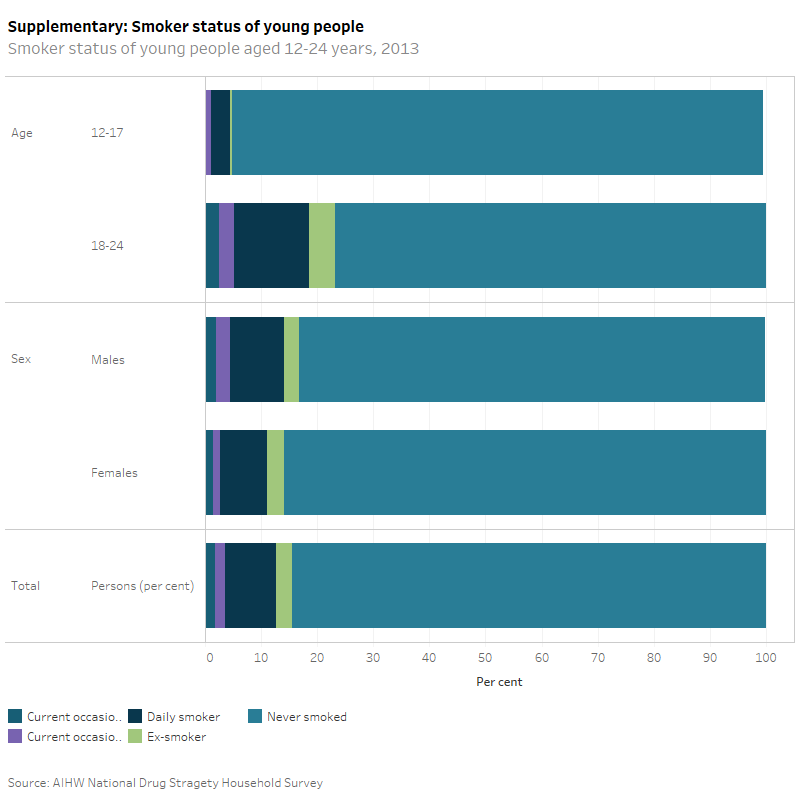Smoking
Why are rates of smoking important?
The detrimental health effects of tobacco smoking are well established. In the short term, tobacco use may lead to respiratory problems, shortness of breath, nicotine dependence (and subsequent withdrawal symptoms), persistent coughing and reduced physical fitness (AIHW 2008). In the long term, tobacco smoking is a leading risk factor for chronic disease and death, including many types of cancer, respiratory disease and heart disease, and is the major cause of cancer, accounting for about 20–30% of cancer cases (AIHW & AACR 2012).
Most tobacco smokers take up smoking in adolescence, with very few people beginning to smoke as adults (Mathers et al. 2006). Those who begin smoking at younger ages (12 or 13 years) have been found to smoke more cigarettes per day on average, and to reach this –higher level of smoking at a younger age than those who begin smoking when they are older (Hoffmann et al. 2006). Adolescent tobacco use is associated with a range of social and health problems in early adulthood, such as continued smoking, problematic alcohol use, and mental health, academic and sleep problems (Mathers et al. 2006).
Do rates vary across population groups?
In 2013, 9.1% of young people aged 12–24 were daily smokers. There was a greater proportion of daily smokers among young people aged 18–24 than 12–17 year old (13.4% compared to 3.4% respectively) and Indigenous compared with non-Indigenous young people (20.3% and 8.7% respectively). The proportion of young males who smoked daily was slightly higher than that of young females (9.7% compared to 8.4%), however, this was not statistically significant.
Most young people aged 12–24 in 2013 had never smoked (85%). Adolescents aged 12–17 were more likely to have never smoked than 18–24 year olds (95% compared to 77%). Young adults were also more likely to be weekly occasional smokers than adolescents (3% compared to around *1%)
Has there been a change over time?
From 2001 to 2013 there has been a decrease in the proportion of all young people who were daily smokers (19% to 9.1%). Over this period there were similar trends among 18–24 year olds (24% to 13%), males (19% to 10%), females (19% to 8.4%) and non-Indigenous young people (19% to 8.7%). Between 2004 and 2013, the proportion of daily smokers aged 12–17 years, decreased from 5.2% to 3.4%.
A significantly lower proportion of Indigenous young people were daily smokers in 2013 (20%) compared to 2001 (39%), though in the intervening years rates varied (there were no Indigenous people captured by the survey in 2004 and in 2007 Indigenous numbers had high relative standard errors and should be interpreted with caution).


*This report is based on survey data; relative standard errors and 95% confidence intervals are provided in the Source data tables: NYIF indicators. Some estimates have relative standard errors or 25% to 50% and should be used with caution. Estimates with relative standard errors greater than 50% have been suppressed. Significance testing was undertaken on values cited in the text; unless otherwise stated, differences were found to be statistically significant.
The National Drug Strategy Household Survey includes those aged 12-24 except in 2001 when 12–13 year olds were not included. The 2001 total is for people aged 14–24.
Ex-smoker refers to individuals who have smoked at least 100 cigarettes (manufactured and/or roll your own) or the equivalent amount of tobacco in their life, and reports no longer smoking.
Never smoked refers to individuals who have not smoked at least 100 cigarettes or the equivalent amount of tobacco in their life.
AIHW National Drug Strategy Household Survey
Data quality statement: AIHW METeOR
AIHW (Australian Institute of Health and Welfare) 2008, Australia’s health 2008: the eleventh biennial health report of the Australian Institute of Health and Welfare. Cat. no. AUS 99. Canberra: AIHW.
AIHW & AACR (Australasian Association of Cancer Registries) 2012. Cancer in Australia: an overview, 2012. Cancer series no. 74. Cat. no. CAN 70. Canberra: AIHW.
Hoffmann B, Sussman S, Unger J & Valente T 2006. Peer influences on adolescent cigarette smoking: a theoretical review of the literature. Substance Use and Misuse 41(1):103–55.
Mathers M, Toumbourou J, Catalano R, Williams J & Patton G 2006. Consequences of youth tobacco use: a review of the prospective behavioural studies. Addiction 101(7):948–58.


